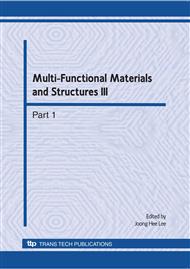p.1211
p.1215
p.1219
p.1223
p.1227
p.1231
p.1235
p.1239
p.1243
Excessive Iron Source on the Structural and Electrochemical Properties of LiFePO4/C Composite
Abstract:
LiFePO4 is one of the most promising cathode materials for lithium ion battery, especially those used in electrical vehicles and hybrid electrical vehicles. However, its very poor rate performance caused by its low electronic and ionic conductivity limits the wide utilization in high power lithium ion battery. Iron phosphides, such as FeP and Fe2P, were reported to have positive effect on the improvement of the rate performance. In order to improve the electrochemical properties, LiFe1+xPO4/C (x = 0-0.1) composite with various contents of iron phosphides was synthesized by adding different amount of iron source during a sol-gel process. The amount of iron phosphides increased with the increase of iron source. Electrochemical performance showed that the samples with 1% iron source in excess had better rate performance than the LiFePO4/C sample synthesized with stoichiometric iron source. However, the overall samples with excessive iron source showed relatively low specific discharge capacity. Hence, some balance between the rate capability and discharge capacity should be found and the amount of the in-situ formed iron phosphides should be optimized.
Info:
Periodical:
Pages:
1227-1230
Citation:
Online since:
August 2010
Authors:
Price:
Сopyright:
© 2010 Trans Tech Publications Ltd. All Rights Reserved
Share:
Citation:


